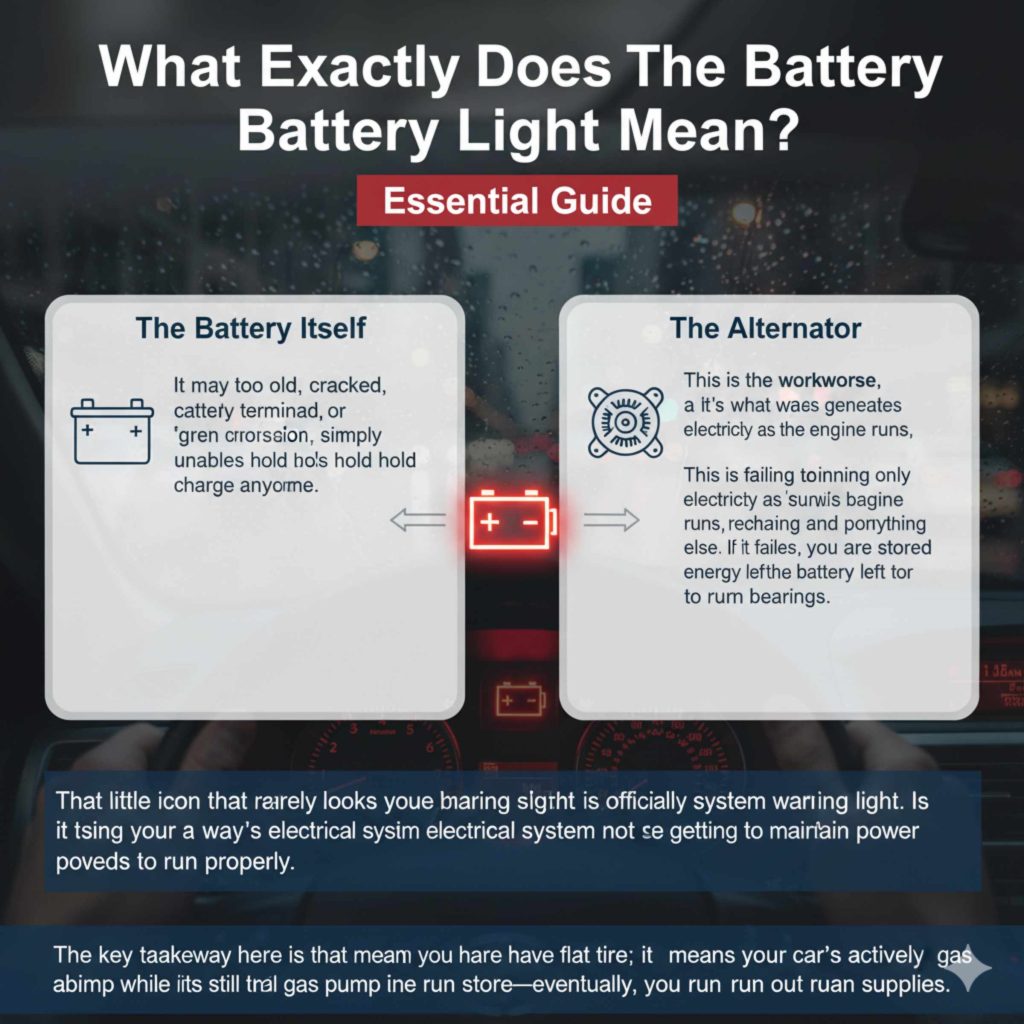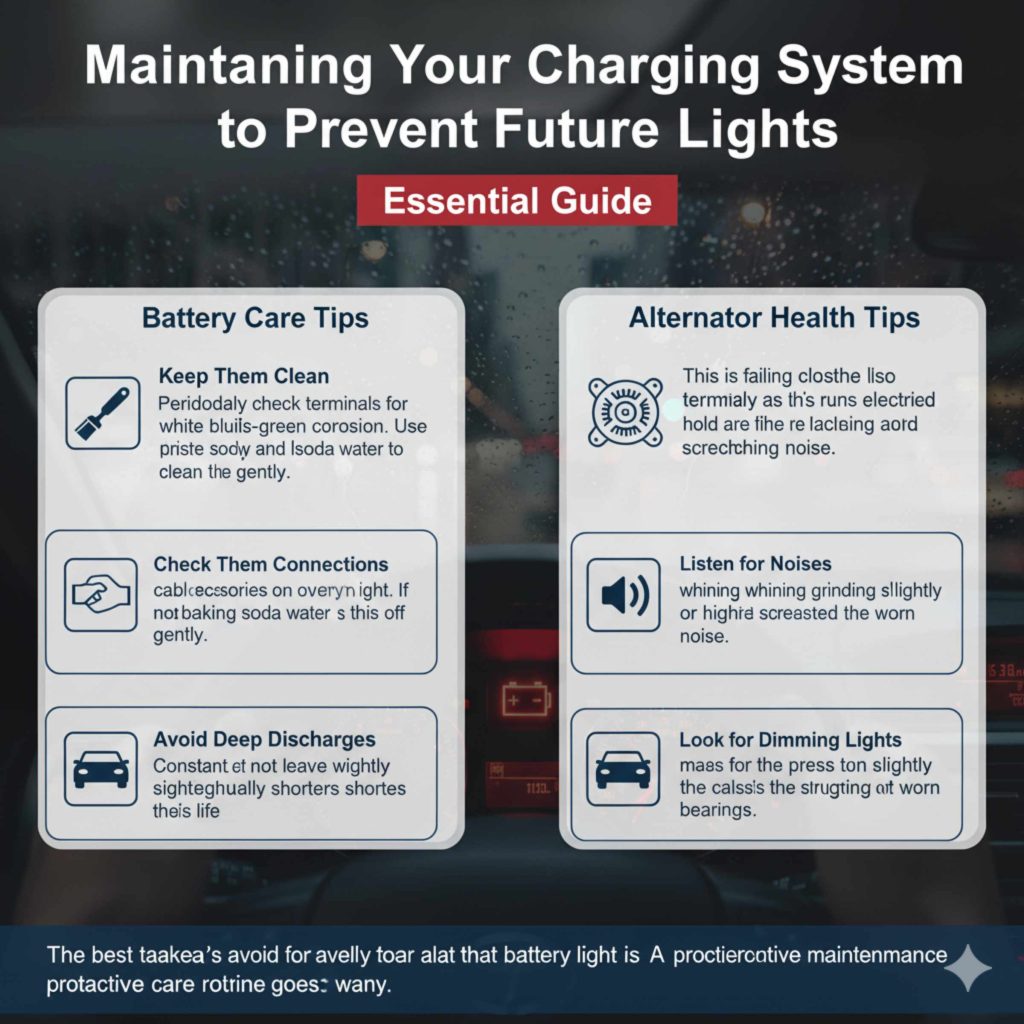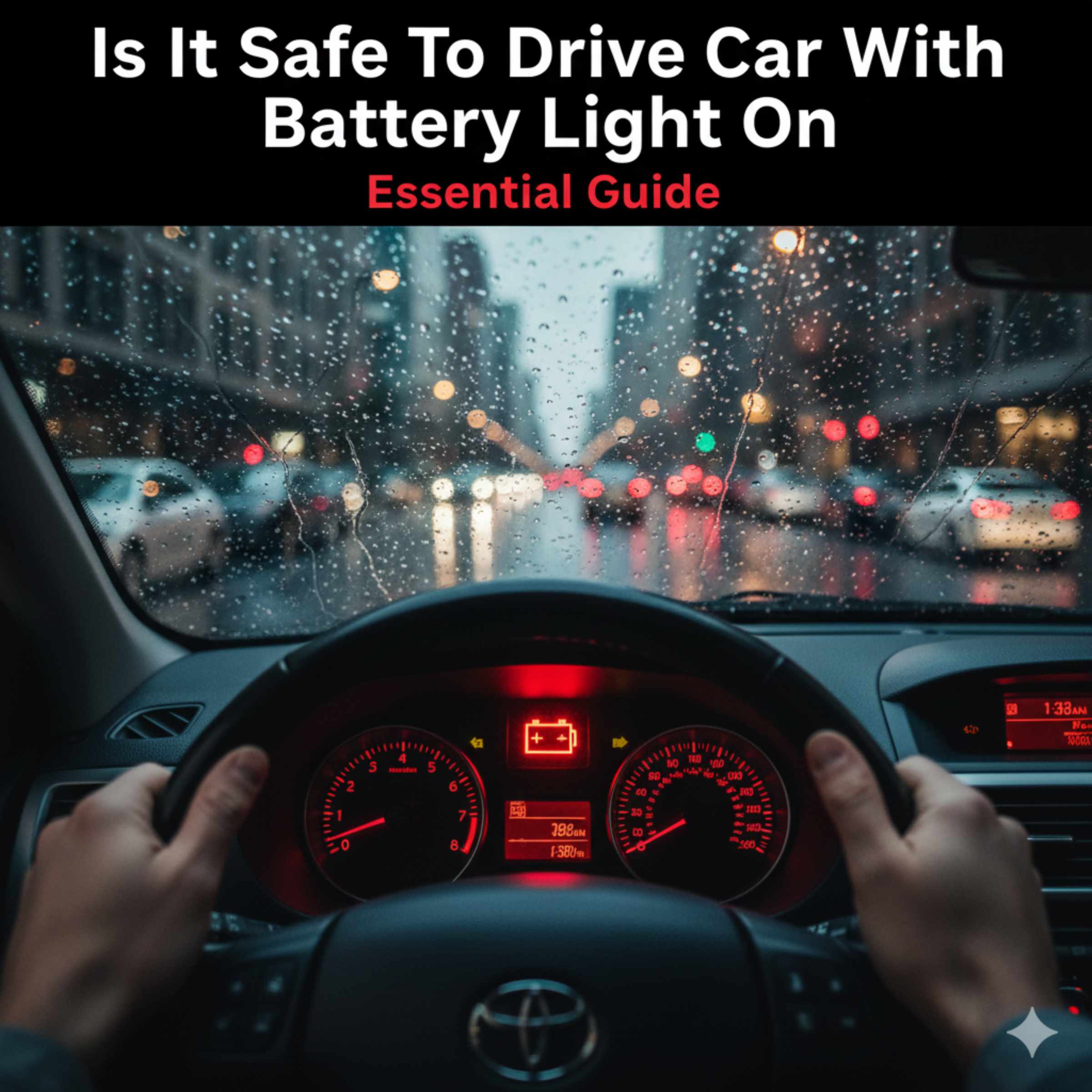Quick Summary: While driving with the battery light on is risky and should be avoided, a very short trip to a nearby repair shop might be possible on a full charge. However, the light signals a major failure in the charging system (battery or alternator). Pull over safely as soon as you notice it, turn off non-essential electronics, and seek immediate professional help to prevent a total roadside breakdown.
Seeing that little battery icon light up on your dashboard can be a real worry. It looks important, and honestly, it is! You are probably wondering: “Can I still get home safely?” This is one of the most common fears drivers have when an unfamiliar warning appears. You do not need to panic, but you do need to act smart. The battery light is not like a low fuel warning; it signals a deeper problem with how your car is making power.
This guide, written just for you, will demystify what that light means. We will break down the difference between the battery and the alternator, explain the risks of driving further, and give you clear, simple steps to take right now. By the end, you will feel much more confident about handling this situation safely and affordably.
What Exactly Does The Battery Light Mean?
That little icon that looks like a plus and minus sign (+) (-) is officially called the charging system warning light. It is your car’s way of telling you that the electrical system is not getting the power it needs to run properly. The system’s job is simple: keep your battery charged while the engine is running so you can use the radio, lights, and ignition.
When this light comes on, it usually points to one of two main culprits:
- The Battery Itself: It may be too old, cracked, or simply unable to hold a charge anymore.
- The Alternator: This is the workhorse. It’s what generates electricity as the engine runs, recharging the battery and powering everything else. If it fails, you are running only on the stored energy left in the battery.
The key takeaway here is that the light rarely means you have a flat tire; it means your car is actively losing its ability to maintain power. Think of it like turning off the gas pump while you are still trying to run the store—eventually, you will run out of supplies.
Is It Safe To Drive Car With Battery Light On? The Honest Answer
As your trusted automotive guide, Dustin Hall, I have to be direct: No, it is generally not safe to drive long distances with the battery light on.
However, safety isn’t a simple yes or no. It depends entirely on what caused the light to illuminate in the first place and how much power you have left in reserve. Here is a breakdown of the risks versus the reality:
The Danger: Why You Should Stop Soon
Your car’s engine needs constant, reliable electricity to run the spark plugs efficiently. If the electrical voltage drops too low (which is what happens when the alternator stops working), the car’s computer systems and ignition system will start to fail. This leads to very dangerous situations:
- Suddenly Stalling: The engine may sputter and die completely in the middle of traffic, which is extremely dangerous, especially on a highway.
- Loss of Power Steering and Brakes: While you will still have some assist momentarily, these systems rely heavily on electrical power. A sudden loss of power can make the car very hard to control or stop.
- Electrical Failures: Your headlights could go out, or your power locks could stop working right when you need them most.
The Exception: The Short Trip Scenario
If the light just flickered on, and you are only a mile or two from home or a trusted repair shop, you might be able to make it. You are essentially running your car purely off the stored energy in the battery. A typical car battery stores enough energy for a short period, usually less than 30 minutes of running the engine, especially if you minimize electrical use.
Crucial safety note: If the light simply switches on and stays on, the alternator is likely dead. If the light starts flashing or suddenly gets brighter, it signals a more erratic electrical problem that could cause a quicker stall. Either way, minimize your driving time.

Immediate Action Plan: What To Do When The Light Appears
The moment you see that battery light, do not hesitate. Follow these steps immediately to maximize your remaining battery life and ensure your safety.
Step 1: Turn Off Non-Essential Electronics
Every accessory running pulls power from the battery. You need to conserve every last volt. Turn everything off that is not absolutely necessary for safe driving.
- Turn off the air conditioning (A/C) or heater fan.
- Turn off the radio and navigation system.
- Turn off any charging devices plugged into USB ports or the cigarette lighter.
- Limit the use of windshield wipers, even if it’s drizzling.
Step 2: Keep Headlights On (If Necessary)
If you are driving in low light or bad weather, your visibility is paramount for safety. Check your local regulations regarding mandatory vehicle lighting—safety on the road comes before component life. If it is broad daylight, turn them off, but never compromise visibility.
Step 3: Reduce Strain on the Engine
High engine RPMs require more power from the alternator (which isn’t working!) to maintain the existing charge. Drive smoothly and slowly. Do not try to accelerate hard or maintain high speeds.
Step 4: Get to Safety or a Shop Quickly
Use a GPS or smartphone to find the absolute closest, safest place to pull over, or the nearest repair shop. If you are on a busy road, aim for the next exit or a well-lit side street.
Diagnosing the Cause: Battery vs. Alternator
Since the battery light covers two components, figuring out which one is the true problem helps you decide your next move. Often, a failing alternator causes the battery light to come on because the battery is no longer being charged. Sometimes, it’s just an old battery that can’t accept a charge anymore.
Here is a simple comparison to help you understand their roles:
| Component | Primary Function | What Happens When It Fails? | How Long Can You Drive? |
|---|---|---|---|
| Battery | Starts the car (provides the initial massive surge of power). | Car won’t crank easily, or accessories dim rapidly. | Only useful capacity when the engine is off. |
| Alternator | Generates power while the engine runs (keeps the battery charged). | Battery light illuminates; car will eventually stall. | Only as long as the battery can supply power (minutes to maybe an hour). |
How Shops Test the System
Mechanics use simple tools to test this system accurately. They often use a multimeter to check your car’s voltage.
- Engine Off Test: A healthy, fully charged battery should read about 12.6 volts. If it reads much lower (say, 11.8V), the battery is dead or dying.
- Engine Running Test: With the engine running, the alternator should kick in and push the voltage to around 13.7 to 14.7 volts. This higher voltage confirms the alternator is successfully charging the system. If the voltage stays at 12.6V (or drops), the alternator has failed to charge the system.
You can find great resources online about testing car batteries at home, but for safety and accuracy, letting a professional check the voltage output is recommended. Many auto parts stores (e.g., AutoZone provides free testing sessions) can often check your system right in the parking lot.
The Risks of Ignoring the Light: What Happens If You Keep Driving?
It can be tempting to think, “I’ll just drive slow, and I’ll make it.” But pushing your luck when the charging system fails can transform a minor inconvenience into an expensive breakdown. Let’s look at the cascading failures that can occur.
1. Total Electrical Shutdown
This is the most common outcome. Once the battery voltage drops below a critical threshold (usually around 10.5–11 volts), the engine computer loses the necessary power to maintain the combustion cycle. The car essentially dies instantly, leaving you stranded wherever you happen to be.
2. Damage to Sensitive Electronics
Modern cars are packed with sensitive control modules (like the ECU—engine control unit). If the alternator is failing, it can sometimes cause voltage spikes or dips rather than a steady drain. These fluctuations can “fry” or corrupt the programming in these expensive electronic components. Replacing an ECU costs significantly more than replacing a simple alternator.
3. Overworking the Battery
If the alternator has failed, the battery is desperately trying to power everything until it runs dry. Once a standard car battery is fully drained (or “deep cycled”), its lifespan is drastically shortened, even if you manage to jump-start the car later. You might end up needing both a new alternator and a new battery sooner than planned.
Step-by-Step Guide: How to Safely Get Help When the Light Is On
If you decide you must move the car, or if the light comes on while you are far from home, here is a safe protocol to increase your odds of success.
Scenario A: I Am Close to Home/Shop (5 Minutes Away or Less)
- Put the car in Park or Neutral if stopped at a light.
- Turn off all accessories (radio, AC, chargers).
- Drive steadily—do not speed up or slow down abruptly.
- If you have to stop, put the car in Park (P) rather than keeping it idling in Neutral (N) or Drive (D), as idling uses slightly less power.
- Once you arrive, turn the engine off immediately until a technician can look at it. Do not try to restart it until professionals confirm the system charges.
Scenario B: I Am Far From Help (More Than 5 Minutes Away)
This requires a call for assistance. Driving further risks stranding you in an unsafe location.
- Pull over to the safest location possible (a parking lot, rest stop, or the emergency shoulder, safely away from traffic lanes).
- Turn the engine off immediately.
- Call your roadside assistance provider (like AAA or your insurance company’s roadside service).
- Explain clearly that your battery light is on and you suspect a charging system failure. Ask for a tow to a certified mechanic nearby.
Remember, professional towing ensures that if the car dies en route to the shop, you are not left stranded dealing with emergency roadside issues. Towing is often cheaper than a massive breakdown repair on the side of the road.
Understanding Repair Costs: Battery vs. Alternator Replacement
Knowing the typical cost difference can help you budget for the inevitable repair. The good news is that neither replacement is usually as expensive as major engine work.
| Repair Item | Average Parts Cost (Estimate) | Typical Labor Time | Overall Difficulty for DIY |
|---|---|---|---|
| New Battery | $100 – $250 | 15–30 minutes | Easy (If terminals are accessible) |
| New Alternator | $150 – $450 (New or Rebuilt) | 1–3 hours | Medium (Requires belt removal and careful wiring) |
If the issue is simply the battery, the fix is quick and relatively cheap. If the alternator is the problem, it involves more labor because it is generally bolted onto the engine block and connected to the serpentine belt system. Be sure to check resources like the National Highway Traffic Safety Administration (NHTSA) for general safety guidelines regarding vehicle electronics.
Maintaining Your Charging System to Prevent Future Lights
The best way to avoid the panic of seeing that battery light is proactive maintenance. A little routine care goes a long way toward keeping your battery healthy and your alternator spinning efficiently.
Battery Care Tips
- Keep Them Clean: Periodically check the battery terminals for white or bluish-green corrosion. Use a wire brush and a mixture of baking soda and water to clean this off gently. This ensures a strong electrical connection.
- Check the Connections: Ensure the cables going to the battery posts are tight. If you can wiggle the cables by hand, they need tightening.
- Avoid Deep Discharges: Do not leave lights or accessories on overnight. Constant deep draining significantly shortens battery life. This is especially important in extreme cold or heat.
Alternator Health Tips
The alternator is generally reliable, but it can wear out due to age or internal component failure.
- Listen for Noises: A failing alternator often makes a whining, grinding, or high-pitched screeching noise, especially noticeable when the engine is running. This sound is usually caused by worn bearings inside the alternator housing.
- Look for Dimming Lights: If your headlights seem to dim slightly when you press the brake pedal or turn on the rear defroster, it’s a clue that the alternator is struggling to keep up with the electrical load.

FAQ: Quick Answers for Battery Light Worries
Q1: Will my car definitely stall right away if the battery light comes on?
A: Not immediately. Your car will run on the battery’s stored charge. However, the longer you drive, the lower the voltage drops, and the sooner the car will stall completely. It is always best to stop driving as soon as possible.
Q2: Can I jump-start my car if the battery light is on?
A: Yes, you can jump-start a car that has a dead battery, provided the alternator is still working. However, if the alternator has failed, the car will only run for a short time after the jumper cables are removed, as there is no device replenishing the charge.
Q3: Does driving faster or slower help when the battery light is on?
A: Slower is generally better. High speeds or heavy acceleration put more electrical demand on the system (even if the alternator is off). Drive calmly and slowly to conserve the remaining battery power.
Q4: Does the check engine light sometimes come on with the battery light?
A: Yes, often. A failing alternator can cause erratic voltage issues that confuse the Engine Control Unit (ECU), causing the Check Engine Light to illuminate, even if the primary physical problem lies with the alternator.
Q5: How long can I safely drive with the battery light on?
A: It is impossible to give an exact time, but assume you have 10 to 30 minutes maximum. If you notice accessories like the radio or interior lights flickering, you are likely closer to the 10-minute mark.
Q6: What if the battery light turns off after I tighten the cables?
A: That is great news! It usually means the issue was a poor electrical connection, not a failed component. However, you should still have the voltage professionally tested within a day or two to ensure the battery is charging properly under load.
Conclusion: Drive Smart, Not Scared
Seeing the battery light is never fun, but you are now equipped with the knowledge to handle it confidently. Remember, that light is your early warning system, not a guaranteed disaster signal. While the safest course of action when the light stays illuminated is pulling over and calling for a tow, understanding your immediate options—shutting down electronics and driving minimally—can get you safely to the mechanic.
By knowing the difference between a simple battery issue and a more complex alternator failure, and by adopting smart preventative grooming habits (like cleaning those terminals!), you take control of your vehicle’s electrical health. Don’t let this warning scare you; use it as a cue to get simple, proactive service, keeping your journeys reliable and worry-free.

